跨文化交际第六章
胡文仲《跨文化交际学概论》课后习题详解(第6章 非语言交际)【圣才出品】

第6章非语言交际1.如果比较语言交际和非语言交际,你认为哪个更重要?为什么?答:非语言交际更重要,原因在于:(1)非语言交际通常与语言交际结合进行,在不同的情况下起着不同的作用,大致上起补充、否定、重复、调节、替代或强调的作用。
我们在机场欢迎客人,一边说:Welcome to Beijing,一边热烈握手。
这握手的动作是对所说的话的一种补充。
当你接到你不喜欢的礼物时,尽管嘴里说如何如何喜欢,但脸上的表情却流露出你的真实的不愉快的表情,也就是说,你的表情否定了你所说的话。
(2)一般说来,在语言交际和非语言交际传达的信息冲突时,人们倾向于相信后者。
我们有时一边说话一边用手势表达同样的意思。
例如,一边说要两杯饮料,一边伸出两个手指,重复已经发出的信息。
在两个人谈话时,常用眼神和语调表示下面该是谁讲话,调节相互的关系。
在有的情况下,无法用语言交流信息,必须用手势或其他办法。
例如,交通警察指挥机动车辆,股票交易所的交易员在嘈杂的大厅里传递买卖的信息和行情都使用非语言手段手势或指挥捧替代语言交际。
在人们讲话时,常常用手势加强语气,或强调某一个论点。
2.在非语言交际的各种手段中,你认为哪一种最容易引起误解?答:(1)在非语言交际的各种手段中,我认为手势最容易引起误解。
(2)各民族都用手势表达意义,但同一手势在不同文化中可以表示并不相同的意义例如,将手掌平放在脖子下面;在我国文化中是杀头的意思,但是在英语国家的文化中却可以表示吃饱了的意思。
即使在同一民族中,由于地区习俗的不同,同一手势也可能会具有不同意义,例如,在广东,主人给客人斟酒时,客人为了表现感谢,用食指和中指轻扣桌面,而在北方同一动作却表示不耐烦的情绪。
(3)有些手势是某一文化所特有的例如,英美人所用的一些手势我们并不使用。
美国人站在公路旁边向上伸出拇指,这是向过往的汽车司机表示,希望能搭他们的车。
英语thumb a ride表达的即是这个意思。
英美人把中指放在食指上面,表示希望事情能办成功。
跨文化交际unit6-verbal-communication

❖ 引言:
❖
各民族的语言是自足的. 处于不同语言世界里的人,即使面对同一个现实面向,
也会在描述它时沿着各自的思路,采用不同的策略, 刻画出不同的版本.正如维特
根斯坦所言:我的语言就是我的疆界,跨出我生于其中的语言,冒险与隔膜就开始
了.
❖
语言与文化紧密相连, 不可分割; 语言是文化的一部分.
❖ Culture and language are intertwined and are shaping each other. Each time we select words, form sentences, and send a massage, either oral or written, we also make cultural choices.
❖ ( Beamer, L. and Varner, I Intercultural communication in the Global Workplace. New York, NY:
❖ Teaching objectives: ❖ In this part you are expected to understand some commonly observed differences
The power of verbal communication
Ⅰ. cultural differences on lexical level ❖ (cases) ❖ 1. types of lexical meaning ❖ Words are the basic units of meaning. Understanding
❖ farther and farther away from home.
chapter6跨文化交际.ppt

Human Information
Auditory Stimuli (officer’s police whistle)
Visual Stimuli (officer directing traffic)
Tactile Stimuli (other pedestrian bumps into you)
be seen is lost or distorted (扭曲) in transit to the human brain.
b. Hearing
Chapter 6 Culture’s Influence on Perception
Hearing refers to the ability to detect sounds. Human beings’ hearing is performed by ears. As with sight, there is a normal loss of fidelity(精确度)estimated at between 22% and 25%.
Chapter 6 Culture’s Influence on Perception
e. Touch
Touch may simply be considered as one of five human senses;however, when a person touches something or somebody, this gives rise to various feelings. Thus the term "touch” is actually the combined term for several senses.
跨文化交际实用教程unit6
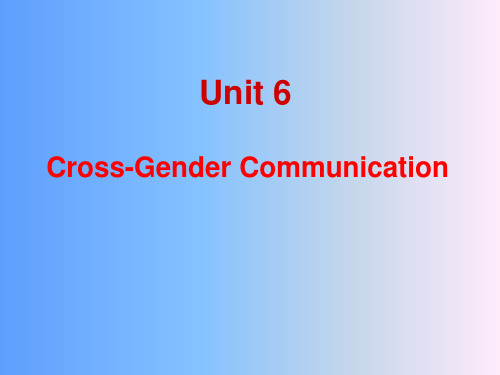
communication.
asking their opinions
Interrupt others o make
and encouraging them your own points.
to elaborate.
7. Keep the conversation going by asking questions and showing interest in others’ ideas.
express
something helpful
understanding of their 6. Don’t share the talk
feelings.
stage with others, wrest
6. Include others in
it from them with
conversation by
Feminine Talk e talk to build and sustain rapport with others. 2. Share yourself and learn about others through disclosing 3. Use talk to create symmetry or equality between people
comments enhance depth of connection
7. Each person is on her or his own; it’s not your job to help others join in.
8. Use responses to make your own points and to outshine others.
Unit 6 跨文化交际
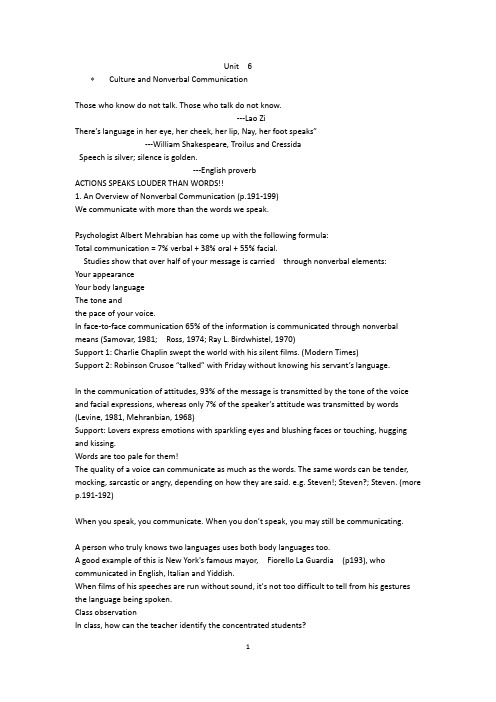
Unit 6Culture and Nonverbal CommunicationThose who know do not talk. Those who talk do not know.---Lao ZiThere’s language in her eye, her cheek, her lip, Nay, her foot speaks”---William Shakespeare, Troilus and CressidaSpeech is silver; silence is golden.---English proverbACTIONS SPEAKS LOUDER THAN WORDS!!1. An Overview of Nonverbal Communication (p.191-199)We communicate with more than the words we speak.Psychologist Albert Mehrabian has come up with the following formula:Total communication = 7% verbal + 38% oral + 55% facial.Studies show that over half of your message is carried through nonverbal elements:Your appearanceYour body languageThe tone andthe pace of your voice.In face-to-face communication 65% of the information is communicated through nonverbal means (Samovar, 1981; Ross, 1974; Ray L. Birdwhistel, 1970)Support 1: Charlie Chaplin swept the world with his silent films. (Modern Times)Support 2: Robinson Crusoe “talked” with Friday without knowing his servant’s language.In the communication of attitudes, 93% of the message is transmitted by the tone of the voice and facial expressions, whereas only 7% of the speaker’s attitude w as transmitted by words (Levine, 1981, Mehranbian, 1968)Support: Lovers express emotions with sparkling eyes and blushing faces or touching, hugging and kissing.Words are too pale for them!The quality of a voice can communicate as much as the words. The same words can be tender, mocking, sarcastic or angry, depending on how they are said. e.g. Steven!; Steven?; Steven. (more p.191-192)When you speak, you communicate. When you don’t speak, you may still be communicating.A person who truly knows two languages uses both body languages too.A good example of this is New York's famous mayor, Fiorello La Guardia (p193), who communicated in English, Italian and Yiddish.When films of his speeches are run without sound, it's not too difficult to tell from his gestures the language being spoken.Class observationIn class, how can the teacher identify the concentrated students?They may show an interested look, wear a smile, make some notes or keep their eyes on the teacher.On the other hand, how can the teacher know the students are not interested in her class? They may consciously or unconsciously twist the body, bury the head, avoid the teacher’s eyes, wear a blank expression, knit the eyebrows or bite the pen.2. What is nonverbal communication?Nonverbal communication involves all nonverbal stimuli in a communication setting that are generated by both the source (speaker) and his or her use of the environment and that have potential message value for the source or receiver (listener). --- (Larry A. Samovar, 1998)In other words, it is communication without words.2. What is nonverbal communication?It refers to communication through a whole variety of different types of signal come into play, including:the way we move,the gestures we employ,the posture we adopt,the facial expression we wear,the direction of our gaze,to the extent to which we touchand the distance we stand from each other.ClassificationBody language/Kinesics(体态语/身势语):posture, head movement, facial expressions, eye behavior, gestures, handshaking, arm movement, leg movement, kiss, hug, touch etc.Paralanguage( 副语言): sound, pitch, tempo of speech, tone, volume, pause, silence, turn-taking etc.ClassificationObject language ( 客体语、物体语) :clothing, personal artifacts (adornment, jewelry, perfume, personal gear etc.) , hair, furniture,vehicle etc.Environmental language(环境语):time language/chronemics , spatial language/ proxemics (interpersonal distance), space, seating, territoriality, color, light, signs and symbols, architecture etc.Body language/KinesicsThe study of how movement communicates is called Kinesics.Kinesic behavior refers to communication through body movements like posture, head movement, facial expressions, eye behavior, gestures, handshaking, arm movement, leg movement etc.Posture---bowPosture and sitting habits offer insight into a culture’s deep structure.In many Asian cultures, the bow is much more than a greeting. It signifies that culture’s concern with status and rank.In Japan, for example, low posture is an indicator of respect. Although it appears simple to the outsider, the bowing ritual is actually rather complicated.---Bow in JapanThe person who occupies the lower station begins the bow, and his or her bow must be deeper than the other person’s.The superior, on the other hand, determines when the bowing is to end.When the participants are of equal rank, they begin the bow in the same manner and end at the same time.---Wai in ThailandThe Thai people use a similar movement called the wai.The wai movement---which is made by pressing both hands close together in front of one’s body, with the fingertips reaching to about neck level---is used to show respect.The lower the head comes to the hands, the more respect is shown.---Crossing legs (1)The manner in which we sit also can communicate a message.In U.S.: normal to cross legs while seated; women cross at the angle while men cross with angle on the knee;Middle East: crossing the leg with angle on the knee is inappropriate;---Crossing legs (2)In Ghana and in Turkey, sitting with one’s legs crossed is extremely offensive;People in Thailand believe that because the bottoms of the feet are the lowest part of the body, they should never be pointed in the direction of another person; In fact, for the Thai, the feet take on so much significance that people avoid stomping with them.---SlouchingIn US, where being casual and friendly is valued, people often fall into chairs or slouch when they stand.In many countries, such as Germany and Sweden, where lifestyles tend to be more formal, slouching is considered a sign of rudeness and poor manners.---Feet on deskIn U.S. and Britain: lean back in the chair and put feet on the desk to convey a relaxed andinformal attitude.Middle East, Swiss and Germany: putting feet on the desk is rude.---Hands in pocketEverywhere in Europe, it is rude to talk with your hands in pocket. It’s something only a guilty child would do.In Turkey, putting one’s hands in one’s pockets is a sign of disrespect.In Germany, “it is impolite to shake someone's hand with your other hand in your pocket. This is seen as a sign of disrespect”In China & Japan, it’s rude to stand with hands thrust into the pocket.---Hands on hipsIn Mexico, it signals hostility.In Malaysia, it shows anger.In U.S., it means impatience.In Argentina, it indicates a challenge.Gestures (p204, p214)Gestures are an important component of non-verbal communication.This is mainly a matter of how we use our hands to convey a message.The language of the hands differs from country to country and a gesture which means one thing in one country may well mean something quite different to those living in another.Let’s look at the examples of how gestures communicate.GesturesThousands of cross-cultural examples prove that messages and meanings shift from culture to culture.An Arabic specialist once cataloged 247 separate gestures that Arabs use while speaking.And in a large study involving forty different cultures, Morris and his associates isolated twenty common hand gestures that had a different meaning in each culture.The ring gesture/OK signIn US &UK, it means OK. It’s great. Everything is fine and going well;In Japan and Korea, it means money;In France, it means zero or worthless;In Russia, it means zero/rudeness;In Brazil, Turkey, Venezuela, it means insult/vulgar;In Tunisia “I’ll kill you.”In Malta, it is an invitation to have a homosexual sex.Among Arabs this gesture is usually accompanied by a baring of teeth, and together they signify extreme hostility.In Mexico and Germany, it has a vulgar connotation.In Argentina, one twists an imaginary mustache to signify that everything is okay.The single finger beckon signIn U.S. & Britain: it simply means “come here” . (just waiving the index finger)In Yugoslavia & Malaysia: it is only used for beckoning animals.In Philippines: it is used for beckoning dogs and it’s considered very rude.In Indonesia & Australia: it is used for beckoning prostitutes. i.e. ladies for the night.In Singapore & Japan: it is a sign for death.Most often than not, in the U.S., when a person wants to signal a friend to come, he or she makes the gesture with one hand, palm up, fingers more or less together and moving toward his or her body.Koreans express this same idea by cupping “the hand with the palm down and drawing the fingers toward the palm.” When seeing this gesture, many Americans think the other person is waving good-bye. (palm not facing people, it is for beckoning the dog in Korea)In China, beckoning gesture: the hand is extended towards the person, palm open and facing down, with all fingers crooked in a beckoning motion.In the Middle East, the beckoning gesture is made by waving the hand with the palm down.In Portugal, it is made by waving the hand with the palm up.In Tonga, it is made by downward waving of the arm.In parts of Burma(缅甸), the summoning gesture is made palm down, with the fingers moving as though playing the piano.Filipinos often summon someone with a quick downward nod of the head.In Germany & much of Scandinavia, a beckoning motion is made by tossing the head back.For many Arabs, nonverbally asking someone to “come here” is performed by holding the right hand out, palm upward, and opening and closing the hand.The thumb-up signIn Britain: OK, good, great, well done; also used as a sign for hitch-hiking.To Chinese: excellent, number one.To Japanese: boss, father, husband.To Persian: discontent.To people in the Middle East: obscene gesture.In Greece it is an insult.In France, it means to show approval.In Afghanistan, Iran, Greece and most part of Italy: get out.Yet, to show approval, it is by raising one’s eyebrows in Tonga,by tilting one’s head in France,and by having two thumbs up in Kenya.The thumb-down signTo most Asian countries: Bad, dislikeU.S. & Canada: DisapprovalIn U.S. also for hitch-hikingGreece: a rude signThe ear-tug signIn Spain it means someone is a sponger, i.e. using other people’s money and never spending his own.In Greece it is a warning .In Italy it is used to call someone a homosexual.In Portugal it is used to express something wonderful.In Scotland it shows somebody doubts what you are saying.In Malta, it says someone is a sneak.The eyelid-pull signPulling down the lower lid of your eye with one finger is usually to indicate alertness.In France, England and Greece, it means: you can’t full me.In Spain and Italy, it means that you should be alert.In South America, it means he finds a woman very attractive.The V-signpalm to observer (palm upward):the number 2;Victory, peace or friend (around the world by peace and counter-culture groups)a gesture used in photographs (by many others, especially in Japan)In Greece: hold up the palm to so meone’s face means insult.palm to yourself(palm inward):the number 2offensive gesture, meaning insult, is often compared to the offensive gesture known as "the finger". (This usage is restricted largely to Australia, Ireland, New Zealand, South Africa, and the UK)is equivalent to “the finger” (in countries where Spanish, Portuguese, or French are spoken, and especially in Spain, Portugal, Brazil, France, and also Italy, Poland, and countries under the influence of Russian culture, such as Russia, Belarus, and Ukraine, but the majority of young people in these countries use the finger as an insult.the finger (the middle finger)In U.S. & most of Europe: a highly offensive gesture.In Western culture, the finger (as in “giving someone the finger”or “the bird” or “flipping someone off”) is an obscene hand gesture.It communicates moderate to extreme contempt, and is roughly equivalent in meaning to "fuck off", "fuck you", "shove it up your ass", "up yours" or "go fuck yourself."The cross-fingers/good luck signIn Italy, it means: “insulting”In Arab world, it means: “wait” or “slowlyIn Vietnam, it’s very rude as this gesture symbolize part of the female body.Anglo-American culture: to wish someone good luck.Germans wish others good luck by making two fists with thumbs inside and pounding them on an imaginary table.To wish some one good luck in Portugal, one would place the thumb between the index and third fingers.Moutza in Greece(all five digits with the palm facing forward)In Greece where the five fingers are spread wide and the palm is pushed towards the recipient: obscene gesture meaning "you have five fathers", thus calling someone a bastard私生子. While originally referring to the custom of punishing criminals by tying them to the backs of donkeys, this gesture has more recently take on a sexual connotation. The Moutza has many variations.The vertical horn gesture/Satanic salute/two-fingered saluteA positive connotation associated with the University of Texas Longhorn Football Team.In Norway: a salute to Satan. According to CBC (Canadian Broadcasting Corporation 加拿大广播公司) news, Norwegians were shocked by a gesture made by President Bush and his family during the inauguration.In Italy, Brazil, Spain, Portugal, Colombia: an insulting connotation, meaning one’s wife is cheating on him;Venezuela, good luck;U.S. subculture: devil’s horn;In China, means number 6.Clasped-hands-over-the-head gestureused by Former Soviet Premier Khrushchev when visiting the US in the 1960s.---for Russians is a sign of international brotherhood;---for Americans it is an arrogant gestures usually used by prize-fighters after defeating an opponent.Left-handers---be carefulThe left hand is not used for eating, (even if you are left-handed) this is considered offensive and unclean in Middle East, India, Sri Lanka, Africa, Bangladesh because left hand is for toilet functions.Mannerly in India to break your bread only with your right hand (sometimes difficult fornon-Indians) .PointingIn the U.S. by extending the index finger;Germany with little finger;Japanese with entire hand (in fact most Asians consider pointing with index finger to be rude)In Mongolia, by pointing with the lips.In India, by pointing with the chins.In Guinea-Bissau几内亚比绍共和国, by pointing with the tongue.CountingThumb = 1 in Germany, 5 in Japan, middle finger for 1 in Indonesia.Chinese 8 gesture means 2 in Japan.Chinese 9 gesture means pick-pocket in Japan.Head movementsHead movements denoting acceptance and rejection take opposite forms in Thailand and the U.S.Greeks express “yes” with a nod similar to the one used in the U.S. ,but when communicating “no”, they jerk their he ads back and raise their faces. Lifting one or both hands up to the shoulders strongly emphasizes the “no”.To Nepalese, Sri Lankans, some Indians and some Eskimos, nodding the head means not “yes”, but “no”.The Indians have a habit of shaking their heads slightly when they talk to somebody. It doesn't mean "No", but "Yes".Facial Expressions (p194-199)In a very real sense, when it comes to using our faces, we are all actors because we all wear a variety of masks. To quote the poet T.S. Eliot, we “put on a face to meet the faces that we meet.”Cultural norms often dictate how, when, and to whom facial expressions are displayed.In many Mediterranean cultures, people exaggerate signs of grief or sadness. It is not uncommon in this region of the world to see men crying in public.Yet in the U.S., white males suppress the desire to show these emotions.Japanese men even go so far as to hide expressions of anger, sorrow, or disgust by laughing or smiling. In one study, Japanese and American subjects revealed the same facial expressions when viewing a stress-inducing film while they were alone. However, when viewing the film in the presence of others, the Japanese manifested only neutral facial expressions.The Chinese also do not readily show emotion for reasons that are rooted deeply in their culture---the Chinese concept of saving face being one of the most important. For the Chinese, displaying too much emotion violates face-saving norms by disrupting harmony and causing conflict.The smile is yet another emotional display that is rooted in one’s culture.In Korean culture, too much smiling is often perceived as the sign of a shallow person. Dressers notes that this “lack of smiling by Koreans has often been misinterpreted as a sign of hostility”. Thais, on the other hand, smile much of the time. In fact, Thailand has been called the “ Land ofSmiles.”Eye ContactEye contact is an important aspect of body language. One could draw up quite rules about eye contact: to look or not to look, when to look and how long to look, who to look at and who not to look at, etc. And these rules vary from culture to culture.Cultural Differences in Eye BehaviorIn English speaking world/Western cultures — see direct eye to eye contact as positive (advise children to look a person in the eyes) , if you fail to meet other people’s gaze, you can be interpreted as being dece ptive, weak, bored, or angry. ( Don’t trust anyone who don’t look you in the eye.)But within USA, African-Americans use more eye contact when talking and less when listening.A prolonged gaze is often seen as a sign of sexual interest.Arabic cultures make prolonged eye-contact— believe it shows interest and helps them understand truthfulness of the other person. (A person who doesn’t reciprocat e is seen as untrustworthy).Japan, Africa, Latin American, Caribbean avoid eye contact to show respect.Respect and attention is shown by looking away from the speakers in Latin America.Answer questions 5 &6 on p196.Touch (p.198-)Touch is culturally determined and each culture has a clear concept of what parts of the body one may not touch.In Western culture, handshake is common (even for strangers), hugs, kisses for those of opposite gender or of family (usually) on an increasingly more intimate basis.U.S.— Note differences between African-Americans and Anglos in U.S. Most African Americans touch on greeting but are annoyed if touched on the head (good boy, good girl overtones). Islamic and Hindu: typically don’t touch with the left hand. To do so is a social insult.Islamic cultures generally don’t approve of any touching between genders (even hand shakes). But consider such touching (including hand holding, hugs) between same-sex to be appropriate.Many Asians don’t touch the head, especially in Thailand (Head houses the soul and a touch puts it in jeopardy).Paralanguage (p.223-224)Paralanguage refers to how something is said rather than the content.Most classifications divide paralanguage into three kinds of vocalizations:(1) vocal characterizers (laughing, crying, yelling, moaning, whining, belching, yawning);(2) vocal qualifiers (volume, pitch, rhythm, tempo, resonance, tone);(3) vocal segregates (“un-huh,” “shh,” “uh,” “oooh,” “mmmh,” “humm”).For Israelis, increased volume reflects strong beliefs toward the issue under discussion.The Germans conduct their business with a “commanding tone that projects authority andself-confident.For Thai people, “a loud voice is perceived as being impolite.”In Japan, raising one’s voice often implies a lack of self-control. For them, a gentle and soft voice reflects good manners and helps maintain social harmony---two important values in Japanese culture.When interacting with Americans, people from cultures that speak softly often believe that Americans are angry or upset because of their relatively loud speech.Silence p.225-226Silence is a powerful communicator. It can communicate–Agreement.–Disagreement.–Confusion.–Respect.–Sadness.–Thoughtfulness, or any number of meanings.“Silence in Asia has commonly been entirely acceptable whereas in the West silence has generally been considered socially disagreeable.” – Oliver(1971)Examples---p.225-226Object LanguageObject language refers to communication through material artifacts, e.g. office design, furniture, clothing ,cars, flowers, tie, knife and fork etc.Furniture arrangement within the home communicates something about the culture.For example, people from France, Italy, and Mexico who visit the U.S. are often surprised to see that the furniture in the living room is pointed toward the television set. For them, conversation is important, and facing chairs toward a television screen stifles conversation. In their countries, furniture is positioned to encourage interaction.The Battle of the Ties:Romney’s Red VS Obama’s Blu e(posted on October 4,2012/blog/the-battle-of-the-ties-romneys-red-vs-obamas-blue/. ) Fashion in Politics:Obama “Out-Styles” Romney 4:2“Dress for Success” should have been on both candidates mind while getting dressed for las t night’s first Presidential debate.Overall both did a good job, but a closer look does indeed show some minor differences. After looking at how their suits fitted, what tie they chose to wear, how the ties were tied, how the shirt cut complemented the rest of the outfit, as well as a few other key points, I give the slight edge to President Obama – winning 4:2 over his opponent Governor Romney.In other words: Obama was the better dressed of the two.Hair Cut: Point Goes to RomneyObama showed up in his usually short buzz-cut while Romney impressed with his well manicured coif. Without doubt, Romney’s more “high maintenance” hair took at least 20 minutes to style –time that was, at least from my point of view, well spent.The Suit: Obama Takes This OneBoth men wore the classic charcoal gray, American cut suit (2 button, notch lapels, double vented, and pleated pants).While both men wore pants that were slightly too long, it was Obama’s suit that fit a b it better around the shoulders.It was a close call, but point goes to Obama.The Tie: Romney’s Red “Power Tie” Takes itConsistent with their parties colors, Obama wore a royal blue tie while Romney decided to dress up with a bold red striped piece.While I personally prefer the color and fine textu re of Obama’s tie, Romney did a better job choosing a bolder and more attention-grabbing color. Romney’s red “power tie” exudes confidence without being overly flashy. The stripes on the tie also added a more “business professional” look that is consistent with Romney’s persona. While Romney’s red tie was bold and attention grabbing it did not distract from his face. The clear winner here: Governor Mitt Romne.The Tie Knot: Obama Takes itObama tied his royal blue tie with a perfectly dimpled Four in Hand while Romney tied a slightly sloppy half Windsor.The shape of Obama’s tie knot perfectly complemented the collar style and the dimple gave the tie a nice textured look and better drape. Romney’s knot on the other hand appeared a bit sloppy. The knot was a tad too large for the collar, and the lack of the dimple certainly was an eyesore for every tie aficionado. Thus, the clear winner here is President Obama.The Dress Shirt: Points to ObamaIt should come to no surprise that both men wore the classic white dress shirt featuring classic medium spread collars and traditional barrel cuffs.While both shirts initially looks the same, a closer look shows Romney’s shirt having shorter collar points. While shorter collar points are more modern, it is a style that requires to be worn with the right suit and tie: a slim fit narrow lapeled suit and slightly narrower necktie – something Romney failed to do. Thus, points to Obama.Accessories: Romney Wins HereAs already seen on the campaign trail, both men keep accessories at a bare minimum. Neither man wears cufflinks, tie bars, or pocket squares (something JFK would have done), but instead opted for a simple and sleep look of wedding ring, wrist watch, and American flag pin.Because Romney chose a slightly larger and more visible flag pin, he deserves to win this point.Accessories: Obama Takes This One(Democratic Fashion: Obama vs. Biden)Unfortunately, politicians tend to dress in a somewhat boring fashion these days. Gone are the days when the president (think JFK) dressed in 3-piece suit, decorated with an elegant white pocket square and paired with a dapper skinny tie and matching tie bar.Instead outfits are conservative and, what some m ay call, even boring. Obama’s and Biden’s outfits are the perfect example. Both keep their accessories at an absolute minimum: No cufflinks, no tie bars, no pocket square, and Joe Biden doesn’t even appear to be wearing a wristwatch. The simple fact that Obama wore a sleek black leather band wrist watch gives him the lead when it comes to accessorizing.Object LanguageIn Germany, where privacy is stressed, office furniture is spread throughout the office.In Japan, where group participation is encouraged, many desks are arranged hierarchically in the center of a large, common room absent of walls or partitions.The supervisors and managers are positioned nearest the windows. This organization encourages the exchanges of information, facilitates multitask accomplishments, and promotes the Confucian concept of learning through silent observation.CLOTHINGSClothing can reflect subgroup identity.•Example:–US Army Combat Uniform(ACU)美国陆军作战服–Traditional clothing of Gambia and the minority groups in ChinaSmellUSA — fear of offensive natural smells (billion dollar industry to mask objectionable odors with what is perceived to be pleasant ) — again connected with “attractiveness” concept.Many other cultures consider natural body odors as normal (Arabic).Asian cultures (Filipino, Malay, Indonesian, Thai, Indian) stress frequent bathing — and often criticize USA of not bathing often enough!Environmental Language“Time talks. It speaks more plainly than words. The message it conveys comes through loud and clear.” (E. T. Hall)The study of how people use, structure, interpret and understand the passage of time is called chronemics.Space--differences in comfortable distance between people. “Space talks.” (E. T. Hall) Proxemics deals with how space influences the communication process.Cultures differ substantially in their use of perso nal space“ – Edward Hall(1959).Low-context cultures -- place relatively less emphasis on nonverbal cues; prefer much less sensory involvement, standing farther apart and touching lessHigh-context cultures -- place relatively more emphasis on nonverbal cues; preferring to stand close, touch, and experience a close sensory involvementChronemics–the study of our use of time.–ancient cultures have established their own system in measuring time which differs from one to another.–Example :•Muslims use moon-based calendar system–The usage of time varies from culture to culture.•Example :–Arabs engage in up to half an hour of informalconversation before turning to business.ExerciseMatching TaskThink over the following and make a proper match between cultures and gestures or the meanings they convey. (p.200)。
跨文化交际第六章
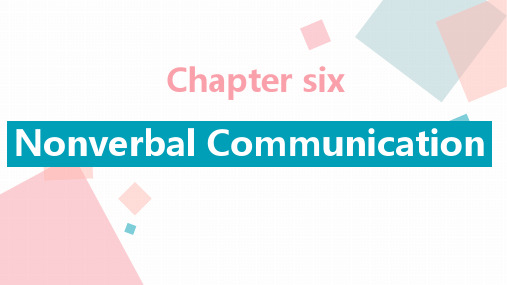
PART
Silence is also speech
We contend that silence can send nonverbal cues concerning the communication situations in which you participate.
Silence can be a powerful message.
First, M-time and P-time are two very separate and distinct categories, and they are much more realistic to perceive Hall’s two classifications as points on a continuum. Second, it is important to remember that how a person “act out” M-time” or “P-time” characteristics is contextual.
Pace
You can determine a culture’s attitude toward time by examining the pace at which members of that culture perform specific acts.
For example:
I.
Americans, because of the pace of life in the United States, always appear to be in a hurry. Nonverbal behavior is often directly linked to a culture’s religious and value orientation. For example: At Ialam, most Muslims believe that their destiny is a matter of fate.
跨文化交际课程unit6
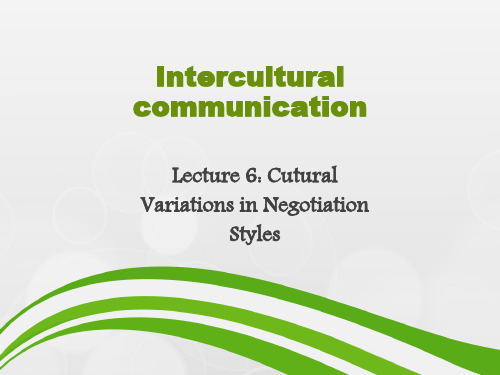
Why did the Japanese think that Americans are barbarians? Why was it so difficult for the Japanese manager to tell his subordinate about his poor performance?
A Japanese manager in an American campany was told to give critical feedback to a subordinate during a performance evaluation. Because the Japanese are used to high context language and are uncomfortable with giving direct feedback, it took the manager five tries before he was direct enough for the American subordinate to understand.
If the boss assigns him to work on a task force, the individualist is likely to see his boss's assignment as a chance to develop his leadership skills;
Cultural Dimensions Power Distance (small and large) Individualism Versus Collectivism Masculinity Versus Feminity Uncertainty Avoidance (low and high)
跨文化交际Unit 6(大二英语)

Chinese tolerant of crowding waiting patiently
English-speaking people cannot stand it try to avoid
Causes
Chinese Englishspeaking people
I. Space
Space talks. -- Edward Hall When you invade my space, I will… feel troubled get defensive become aggressive retaliate
Proxemics
the study of personal space for the purpose of communication (近体
Culture & Space
Japanese
German
Culture
American French Arab Latin American
Small space
Large space
Space affects human communication in many other ways.
Classroom arrangements of desk and chairs A circular arrangement Sit in rows
M-time P-time
Touch Culture vs. Non-touch Culture
Touch culture
Arabs Southern and Western Europeans
Unit_6Nonverbal Communication 跨文化交际 大学教学课件
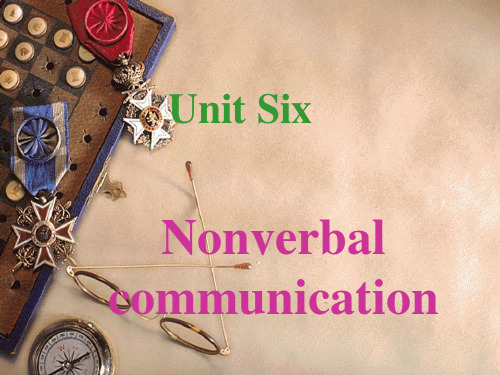
Bowing in Japan
“bowing contest”
Bend slightly to one’s right
Becoming automatic movement, e.g. bow when making phone call
In Japan, mutual bowing is largely determined by rank.
answering a question Korean – rarely do, too much smiling is a sign
of shallowness “The man who smiles a lot is not a real man.” Thailand – “the land of smiles”
regulatingaheadnodtoindicatethatitishisherturntospeak交际中话语插入轮流发言以及交际双方的情绪反应态度变化等借助非语言交际来完成?5
Unit Six
Nonverbal communication
Learning objectives :
Warm-up Activities
You don’t just “ read ” others’ language;
You observe, analyze and interpret before you decide the possible meaning!
Sitting or Standing?
In western countries, people who stand are more important than those who sit (unless there is a table between them), because the former could control the latter.
unit6跨文化交际讲解

Interpreter’s awareness of and competence for cross-cultural communication
1. Warm-up
Part I English-Chinese Interpretation
Good morning. This past week I traveled to Austria and Hungary, where I had productive meetings with our European allies. //We discussed the challenges and opportunities we share, including the importance of spreading prosperity at home and around the world. //It's good to be back to America, and I'm pleased to report that our economy is strong, growing, and delivering prosperity to more of our people.
语用失误
语用失误 1.语用语言失误(pragmatic-linguistic)
2.社交语用失误(sociopragmatic failure)
1.语用语言失误(pragmaticlinguistic)
语用语言失误指的是当说话人在某一表述中使用的语 用方式系统性地不同于将语言作为母语使用的说话人 在这一表述中经常使用的语用方式时,而产生的失误。 (1)汉英词语一一对应,忽视了两者间的及时地积极地从国外引进技 术 , 并且认真组织科学技术人员和广大职工做好消化和 推广工作。 译员:We should further simplify procedures and take prompt and vigorous actions to import urgently needed technologies and earnestly organize scientists , technicians and the mass of workers to assimilate and popularize imported technologies.
跨文化交际复习unit 6
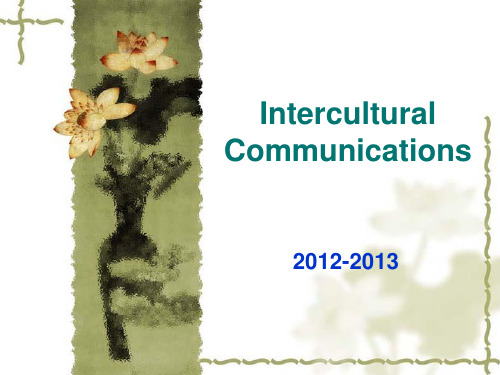
Classification of nonverbal language
Body language: posture (the way the body is held), stance (the way of standing), facial expression, eye behavior, gesture, head movement, handshaking, arm movement, leg movement, etc. Paralanguage: speed or tempo of speech, volume, pause, sound, pitch, turn-taking, silence, etc.
Definitions
Nonverbal communication is the study of facial expressions, touch, time, gestures, smell, eye behavior, and so on.
Nonverbal communication will be defined as the
6.1 Body Language
A. Gesture
B. Posture
C. Eye contact
D. Facial expression (smile) E. Handshaking F. Bowing in Japan
hand gestures
chapter 6跨文化交际

Chapter 6 Culture’s Influence on Perception
How many babies can you see in this picture?
Chapter 6 Culture’s Influence on Perception
Auditory Stimuli (car horns)
Human Information
Auditory Stimuli (officer’s police whistle)
Visual Stimuli (officer directing traffic) Taste Stimuli (flavor of bitter)
f. Body Movement
Chapter 6 Culture’s Influence on Perception
Two senses give people information about their own body movements: kinesthesis(运动感觉)and equilibrium(平衡). Sensation is a neurological process. We are not directly aware of what is in the physical world, but, rather, of our own internal sensations.
How many horses are there in this picture?
Chapter 6 Culture’s Influence on Perception
How many persons can you identify in this picture?
跨文化交际chapter6

5.Invitation and Saying GoodBye
In the culture of British and America, it is very important to consult a time before you invite somebody to attend a banquet or take part in social activities. Esp. in America, invite somebody means you are borrow times of others. So they respect time very much. While in China, people are prefer to an uninvited guest. And otherwise, You will be thought unfriendly if you cannot receive an uninvited guest very well.
3. Thanks and Responses
“Thank you” is widely used in English to show gratitude in such cases as being invited, helped, given a gift, etc. Cultural differences exist between Chinese and western in how to express thanks and responses.
跨文化交际第六章

第六章交际礼仪中国的俗语说“礼多人不怪”,意思是,在交往中以礼待人不会令人反感。
事实上,以礼待人不止不会招致他人反感,而且能够帮助我们得到他人的欢迎和礼遇。
我们在交往中要接触形形色色的人,人们对于“礼”的理解又不尽相同,“失礼”也就在所难免,待人接物“彬彬有礼”也就成了一种挑战。
当交际的双方使用不同的语言、具有不同的文化背景时,加深双方在基本礼仪常识方面的了解和理解,消除礼仪差异造成的交际障碍,提高交际的有效性,是成功的跨文化交际的关键。
本章将主要介绍服饰容貌、见面问候、仪态举止和西式宴请四个方面的跨文化交际基本礼仪常识,旨在为全球化生活、学习和工作环境中的交际者提供基本的行为指引。
第一节容貌服饰礼仪尽管人类远古的祖先开始着装穿戴的理由可能非常简单——只是为了抵御诸如严寒、烈日和野兽攻击等恶劣自然环境带给他们的威胁——我们还是必须承认,人类着装的演变和多样性早已是社会文明发展的一个标志。
伊甸园中的亚当和夏娃,偷食了禁果之后懂得了区分正邪善恶。
他们的第一个意识就是赤身裸体让他们倍感尴尬,于是连叶成裙着了衣装。
人类——无论清醒还是睡眠、无论独处还是与人相对、无论活着还是刚刚逝去——几乎所有的时间都在服装的包裹之中。
当我们身无片缕的时候,我们往往出于本能的藏匿自己而不是将自己暴于人前。
服装就像我们的皮肤一样是我们身体的一部分——一种特殊的、让人类有别于其它动物、让一个人有别于其它人的皮肤。
尽管“以貌取人”在人际交往中并不是可取的态度,我们还是必须承认,“穿着打扮”在很大程度上决定了我们是否能够给他人留下良好印象从而建立良好的人际关系。
因为,一个人对于自己服装的选择,能够反映这个人的性格、素养和品位等等,甚至能够促使他人做出诸如这个人是否值得信任、是否可以继续交往的判断。
在不同的场合恰当的着装首先是对在场所有人的尊重,同时也是积极展现自我的有效方式。
着装就像语言一样帮助人们传递着彼此的信息、成功的进行交际——一种生动形象的、代表不同文化却又跨越不同文化的通用语言。
跨文化交际课程第六单元

Functions of Nonverbal Communication 非语言交际的功能: 非语言交际的功能:六种功能
1)重复(Repeating) )重复( ) 是指可以起到重复语言信息功能的非语言信息,在语言信息不存在时 可以单独起作用。例如,当你在麦当劳买了两个汉堡包时,可能会说 出要买两个汉堡包,同时又伸出两个手指表示“两个”。此时非语言 信息和语言信息相互重复。 2)补充(Complementing) )补充( ) 有些非语言和伴随的语言信息是一致的,或补充、或强化、或澄清语 言信息。例如,一对恋人中的一个对另一个说:“I love you.”,后者 当然可以感受到这一信息。但如果两人坐在一起热烈拥抱时,用愉快 的口吻说出这句话,这一信息会更加强烈。 3)替代(Substituting) )替代( ) 当发出的是非语言信息而不是语言信息时,非语言信息就起到了替代 功能。挥手告别和做手势让人过来,都是常见的例子。盯住某人等于 说一些不好听的话,沉默可以传达不快、冷漠、恼怒等信息。
Reading I (P192)
Question 2 The British English speaker may think that the Indian gets angry with him or behaves rudely Towards him, so he may complain about the Indian’s rudeness or even behave rudely as a Response.
学者们认为,触摸可分为五类: 1)功能职业触摸:这是非个人性的触摸。当医生在体检中触摸病人时, 实际上是把病人当作“物体”看待的。 2)社交礼节触摸:在社交礼节触摸中,不是把对方只看作 “物体”,而 是 把对方看作社会角色,并愿意对其表示尊敬。例如,在英汉文化中, 新经介绍的人相互握手是社交礼节触摸。 3)友情温情触摸:这种触摸是让别人知道我们欣赏他们的一种主要手 段,例如握手、拍肩膀、拥抱都可以看作是友情温情触摸。但是因英 语文化是非接触性文化,人们对与友情有关的接触和与性有关的触摸 之间的差别要小心对待。 4)爱情亲密触摸:这种触摸包括接吻、抚摸面目或头发等。如果不愿意 确立一种爱情亲密关系,这种触摸会使人感到不舒服。 5)性唤起触摸:这是最高水平的身体接触,被看作是表达身体的吸引力。 在这五类触摸中,和英语学习者关系最密切的是社会礼节触摸和友情温情 触摸。这也正是存在跨文化差异的地方。
- 1、下载文档前请自行甄别文档内容的完整性,平台不提供额外的编辑、内容补充、找答案等附加服务。
- 2、"仅部分预览"的文档,不可在线预览部分如存在完整性等问题,可反馈申请退款(可完整预览的文档不适用该条件!)。
- 3、如文档侵犯您的权益,请联系客服反馈,我们会尽快为您处理(人工客服工作时间:9:00-18:30)。
文化休克CULTURAL SHOCK
我作为一名志愿者在美国的一所中学里工作了7个月,刚来的时候我觉得一 切都很新鲜。可是最近我的情绪不高,越来越不喜欢这个国家了。
有一次聚会,我跟一个朋友说:我的英文不好。我其实是期望我的朋友说: “你的英文很好,现在比刚来的时候进步多了。”可没想到,我的朋友却说: “是的,你的英文是不好,还要多练习,你们中国人说英文都不太地道。”她还 说:“你戴眼镜的样子像一只麻雀。”她的话让我心里很不舒服,心想:“就你 说的那两句中文,我还总说你中文说得好呢,我的英文比你的中文好多了。”她 是不是对中国人不友好?聚会快要结束时,我跟她要手机号,没想到她居然不给 我。
失灵。 • 具体来说有什么症状呢?
文化休克的症状
• 感到孤独和无助 • 时常想家,感到寂寞与闷闷不乐 • 烦躁和焦虑,容易为小事动怒 • 害怕被欺骗、抢劫或伤害 • 过度认同自己原有的文化 • 动不动就洗手,过分关注个人卫生和健康 • 惧怕与异国人接触,敌视当地人 • 身体疼痛或不适
• ALDER(1997)文化休克本质上是一种跨文化的学习,自我认识和改变。 • BRISLIN:文化休克的经历不仅不阻碍文化适应,还可能会使文化适应更有效率。 • 文化休克也可能给个人生活和跨文化交际带来一些积极效果。
上汉语课时一个学生说她肚子疼,我就问她:“你是不是拉肚子?”没想到 别的同学都笑起来,那个学生一下子就不高兴了。没过一会儿,一个学生居然学 我不标准的英文发音。我在这里怎么一点尊严都没有呢?
在国外,我发现自己经常会受到关于衣着的赞美。比如图书馆老师会对我说,她覚得 我穿的玫红色大衣色鲜艳,非常适合我。而早上开会时,另一位老师也说很喜欢我粉色的 衣服,她也经常会穿着这种颜色。起初,我觉得受到赞美很开心,后来我却发现,赞美穿 着是他们寒喧的一个热门话题,属于交际的一部分,他们从小就在这些礼仪方面受过很好 的训练。平常在学校里,低年级的学生也会时常跟我说“我很喜欢你的衣服鞋子”“我很 喜欢你这一身的搭配”。但是我却很少赞美他们,尽管有时候我也会觉得别人的服饰好看, 但可能是因为害羞,我只会在心里评价,却不会宣之于ロ。在中国,很少有人会直白、频 繁地夸赞别人的衣服,哪怕有人夸赞,人们一般也会用“哪里哪里”这样的回答来表示谦 虚。因此,在国外受到这样的李赞时,我常常会觉得他们言过其实,党得他们有些夸张。 面对这种热情的夸赞时,我难以同样热情地表达感谢,而是经常说“这件衣服买了很久了” 这样的话,大概是谦虚的本能暴露了出来。
• 来美国后不久,在大学城的商店购物,素昧平生的祖母级店员找钱时,居然称呼我 “HONEY” 叫我大吃一惊。“HONEY”不是电影里夫妻、情人的互称吗?
• “不是的,这是美国人人情味的表现,没有什么私情关系”。这“大吃一惊”是对美国人 社交生活方式的适应不良。
• 犹记得抵达美国不久,有一日在校园的林荫大道慢跑。迎面而来的是一位 天使面孔、魔鬼身材的金发丽人。没想到在擦身而过之际,她脸带微笑, 嫣然对我说了声“嗨”!小生我一向自认长相平庸,既无玉树临风之姿, 亦无小白脸之貌,所以在女同胞面前吃不开,早已习以为常。现在居然有 如此美女示好,难道是国内诸姝有眼不识泰山,还是番婆的要求太低?
• TIPS FOR CULTURE SHOCK& RE-ENTRY SHOCK: • 广交朋友,建立良好的人际关系;学习目的国语言; • 了解目的文化的知识;做自己感兴趣的事 • 参加社会文化活动IMMERSION;改变自己的思维—我来这里就是为了接受挑战的 • 返乡休克;分享出国经历;寻找出国伙伴
• 到新环境居留的时间和目的不同,适应模式也有所不同。这些有哪些分类呢? 旅游者;旅居者;移民;难民
• 一般到其他国家短暂居住的人们,为了工作、事业或求学,必须身居异国一段时间,之后 会回到自己的国家,这种叫做旅居者(SOJOURNER)
• 跨文化适应策略的影响因素: 1.对保持自身原有文化传统和身份的态度; 2.个人寻求与新环境主流文化建立新的人际关系的模式。
跨文化适应
第一节 文化适应
• 印象最深的是,当时念的是政治,全班只有我一个外国人,上课时常常鸭子听雷——苦闷 万分。有一天终于鼓起勇气向某位友善的洋同学商量借笔记参考,没想到她当场拒绝,气 得我回家后大哭一场,暗恨美国人的缺乏人情味,只好努力看书来弥补英文听力的不足。
• 这是对美国人讲独立、重竞争的文化价值观的适应不良。
包括对模糊性的容忍程度、内在动机、灵活性、幽默感、内向与外向等。 • 期望值是决定性因素之一,它影响一个人在目的文化中的思维、态度和行为。
如,许多中国教师期望学生尊重老师遵守纪律 • 社交支持
包括家人、朋友和社交网络。 • 目的文化的知识
思考:包括哪些内容?
第二节 文化休克
• 文化休克的含义: • 是一种心理焦虑,主要是由于人们日常生活所熟悉的文化语言与非语言符号突然间的异地
四、文化适应与第二语言学习
• 文化适应假说SCHUMAN(1986):学习者只有适应了第二文化才能习得第二语言。 • 社会距离决定第二语言学习者与目的语接触的数量;决定第二语言学习者对于可获得语言
输入的开放程度。 • 二语习得中关键期假说 (CRITICAL PERIOD HYPOTHESIS) • 一个人从出生到青春期(12岁)是学习外语的最佳时期,错过了这个时期家JOHN BERRY
• 同化ASSIMILATION(放弃本有) • 分离SEPARATION(避免接触) • 融合INTEGRATION(最理想) • 边缘化MARGINALIZATION(独来独往,与同胞都不怎么接触)
短期旅居者: • 蜜月期; • 挫折期; • 恢复期; • 适应期
• 跨文化心理学有两大理论: • 文化学习理论(CULTURE LEARNING APPROACH) • 焦虑处理理论(STRESS AND COPING APPROACH) • 影响文化适应的因素
• 文化距离 指的是自身文化与目的文化之间的差异。 思考:1.文化距离的差异包括哪些方面呢?
2.文化距离大小和文化适应之间的关系是什么? • 个人性格特点
• 这是因文化对儿女管教方式的差异所带来的适应上的悲剧。
• 跨文化适应(INTERCULTURAL ADAPTATION / INTERCULTURAL ADJUSTMENT)泛 指对一个新文化环境逐渐感到贴切或相称的过程。
• 跨文化适应的研究,通常着重在居于异国的人们,适应新文化过程所产生的矛盾、焦躁、 烦恼与痛苦的心理冲击,又被称为文化休克。
• 可别会错意,以为天将美色给你。“嗨”、“HOW ARE YOU”、“HOW ARE YOU DOING”等都是美国人对陌生人有礼貌的寒暄用语。
• 不久,朋友发生一件令他们痛苦不堪的事情。十三岁的女儿正当反叛年龄,常离家外出, 不喜学习,不爱做家务,也不愿收拾房间。朋友用自己的尺度来衡量,不可容忍,一时冲 动,掌掴了她。哪知,事情因老师知悉并报警而闹大了。等我赶到她家时,三个女儿已被 政府保护儿童部门一起带走了。她夫妻也正被警察调查,作为一宗罪案来处理。朋友用饱 含泪花的眼神,看了我一下,便被警方带走。这样的情景,把我震惊的傻了眼,一颗重重 的心不断下坠。在美国,不仅不能体罚孩子,连动口骂骂管训不成的子女都得看看窗户有 没有关紧,以防邻居误以为你在虐待孩子,电话一通,警察就来。想起以前的父母管教儿 女之威风,处罚手段之自由,正想一头撞墙,自悲当今父母在管教孩子的权力上,给剥夺 得像只无毛的鸡一样。
者很难达到母语者水平。 • 文化关键期假说BROWN (1980),后又发展成“最佳距离模式”:第二语言和文化学习的最
佳时期出现在文化适应的第三个阶段——恢复期。
开始时,我对他们这种过于热情的人际交往方式有些抵触,觉得像是在演, 并不是很真诚。后来我的住家看我对她的夸赞没有什么反应,也就很少说了,反 倒是我已经习慣了这种交住方式,开始期待她的夸赞了。澳大利亚人非常喜欢夸 赞别人。即使是买了一条新围巾,旁边的人也会非常热情地赞美。起初我党得夸 张,分不出来这是真的还是只是客套,后来我才发现他们的习惯就是这样,是我 应该改变自己的交际方法。这种尝试对我来说还是有些困难。某天LISA做了手工, 我试着去夸她,然后她很高兴我也很开心,我越来越喜欢这样的交往方式了。
